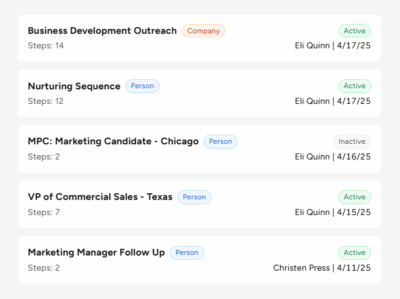Just by its very name, the recruitment and selection process denotes two main parts. Although they may be distinct, they are also interrelated in their nature and intertwined in their purposes. And it doesn’t matter if you’re a professional recruiter, a corporate recruiter, or a member of Human Resources, you need to be proficient with both parts of the process.
What is the recruitment and selection process?
But first, the question that has perhaps brought you to our little corner of the world. What is the recruitment and selection process?
The recruitment and selection process is the process by which a recruiter—agency recruiter, internal recruiter, or otherwise—identifies, engages, recruits, and hopefully hires a qualified candidate for a specific job opening. The process involves multiple steps starting with the creation of the position opening and job description all the way to the offer of employment. The specific number of steps involved depends upon the organization, the industry in which the organization operates, and the preferences of people involved in the process, among other factors.
While there are multiple steps involved, as mentioned above, there are two main parts:
Recruitment—The active recruiting of job seekers and candidates for an open position, this part entails everything involved in the process up until the point that company officials are ready to make a decision.
Selection—This is the point at which recruiters and hiring officials must decide upon the candidate to which they wish to make an offer of employment. Through consensus, they are selecting the candidate they believe to be the best fit for the position.
If the selected candidate accepts the offer, then the organization successfully recruited them. If the candidate does not accept the offer (or disappears from the face of the Earth by “ghosting” the offer), then the organization’s recruitment and selection process has failed.
Steps in the recruitment and selection process
The process of recruitment and selection begins with recruiting candidates and ends with selecting a candidate to hire, as you might expect from the name. Being thorough and following each step can lead to better hires and retention rates. You can start by considering this seven-step recruitment and selection process example.
Take a look at the steps of recruitment and selection:
- Receive a job order
- Source candidates
- Screen applicants
- Shortlist candidates
- Interview candidates
- Conduct testing
- Extend a job offer
Follow each step in the recruitment and selection process to learn as much as you can about each candidate. To prevent your recruitment and selection process from getting stale, find what works and change what doesn’t.
1. Receive a job order
When you receive a job order from your client, you can get the recruitment process rolling. A job order should include information about the position you’re filling and a well-written job description.
The job description should tell potential applicants everything they need to know about the job, including:
- Job title
- Detailed description of the job
- Required and preferred qualifications
- Location
- Salary range
If the job description does not give enough information, or if it is not written in a way that could attract top talent, consider re-writing it.
To find applicable candidates, you need to understand the job order. Ask your client questions about the job order if you need more clarification.
2. Source candidates
Once you fully understand the open position, the next step of the recruitment and selection process is to source candidates.
There are many ways you can source passive candidates and active candidates. Active candidates are those actively looking for work while passive candidates are not. Successful recruiters are able to source both types of candidates.
You can source candidates using the following tools and sources of recruitment:
- Social media
- Online job boards
- Your recruiting database
- Referrals
Social media is a great tool for finding both active and passive candidates. You can post job descriptions on your social platforms.
Online job boards attract active candidates. And, some job board integration works with your recruiting software, so you can add applicant information directly into your database.
Your own recruiting database is a great resource for sourcing candidates. If you use recruiting software with an applicant tracking system, you have candidate information stored. You can reach out to candidates to let them know about the open position.
Many people can refer you to top talent. Talk to candidates you successfully placed. And, you can work with other recruiters in split placements by sharing job orders and candidates.
3. Screen applicants
Screening applicants is a vital step in the recruitment and selection process. This is where you can learn more about each applicant, which helps you narrow down your pool.
You can conduct telephone screenings and include a variety of pre-screening interview questions. During screenings, ask behavioral interview questions that allow you to learn more about the candidate’s personality and how they would function in the open position.
Ask candidates about themselves, including their work history and career goals. Verify that they understand the job description and are qualified.
Phone interviews should last about 30 minutes. Though they won’t be as long as a full interview, you can still learn enough to help you narrow down candidates. Create a candidate scorecard to rank candidates and keep track of their responses. Take notes so that you can compare candidates after you have talked with all of them.
4. Shortlist candidates
Recruitment shortlisting is the process of advancing a few candidates from your pool. Your shortlist of candidates should be around three people.
These are the candidates you want to invite for a face-to-face interview with your client. Your client does not have time for one-hour interviews with 20+ people.
Narrowing down your pool of candidates can be challenging because you don’t want to advance the wrong candidates. Take the time to learn about each candidate’s experiences, qualifications, and personality so you can be confident you shortlist the right people.
5. Interview candidates
After you have narrowed down your candidates, you need to pass along their information to your client. Then, your client will interview the candidates. Typically, you should be present during interviews to take notes, ask questions, and give your opinion afterward.
The face-to-face interview helps you and your client really get to know the candidates. You can study their body language and ask more behavioral interview questions. The interview process helps you and your client get a feel for the candidate’s work ethic.
Again, use an interview scorecard to rank candidates and compare them later. Rank candidates on things like experience, education, and skills.
6. Conduct testing
To further test a candidate’s skills, you and your client might consider conducting job-fit tests. A job-fit assessment test helps you and your client determine how the candidate would mesh with the company.
A job-fit test can take anywhere from 30 minutes to one hour. It asks a series of questions candidates must answer honestly.
You should also conduct background checks on each candidate. And, you need to check references to verify information and learn more about their character and work ethic.
7. Extend a job offer
The final stage of the selection process is actually selecting a candidate. Extend the job offer to the candidate your client wants to hire.
The candidate might try to negotiate the salary your client offers. Talk with your client to see whether the requested salary is possible.
If the candidate declines the job offer, you will either need to go back to the other top candidates or restart the recruitment and selection process.
The recruitment and selection process and the best ATS
The recruitment and selection process is made easier when you use an applicant tracking system or ATS. In fact, it’s made even easier when you use one of the best ATS packages on the market. What is one of the best ATS packages on the market? Thank you for asking? The answer is Top Echelon Software, the leader in recruiting and hiring software for small to medium-sized businesses and recruiting agencies!
Top Echelon Software takes you through every step of the recruiting and hiring software, including:
- Sourcing targeted job applicants through our branded careers page, social media sharing, and job posting options
- Screening candidates quickly and accurately with powerful assessment tools
- Communicating with your short list of candidates, setting up phone screens and face-to-face interviews
- Collaborating with your colleagues through the software to compare notes so you can make your final selection
And right now, you can get free recruitment software for 15 days as part of your trial of Top Echelon Software. See for yourself how Top Echelon can help you streamline and maximize the recruitment and selection process so that you can hire the top talent you need to succeed. You can also request a live recruiting software demo of our applicant tracking system. We’ll show you the ins and outs of the software and how it can make your life easier.
Are we the best ATS for executing the recruitment and selection process? Try us out and decide for yourself!
And in the meantime, also check out Top Echelon’s recruitment software pricing page. Because not only are we one of the most powerful applicant tracking systems on the market, but we’re also one of the most affordable. And can you beat the combination? We submit that you can not!









